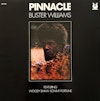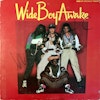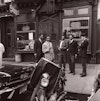Take a moment to consider the incredible diversity and volume of jazz music that came out in the 1970s. Major labels continued to back boundary-pushing music, and independent and artist-run labels filled every record bin with an astounding assortment of jazz from the traditional to farthest of the out. It seemed every musician found an opportunity to release a personal project during the ’70s. And so it was for Buster Williams, the steady-handed bassist who had spent nearly two decades touring and recording with a murderers’ row of legendary leaders before waxing his own album as a leader, Pinnacle, in 1975.
Born in Camden, New Jersey, Williams was raised amid the rich Philadelphia jazz scene, just across the Delaware River. His father, Charles Williams Sr., was a renowned bassist who became his son’s biggest influence, eventually passing gigs on to Buster in the late 1950s, which led to Buster’s first tour with saxophonist Gene Ammons. Backing up big name vocalists like Sarah Vaughan and Nancy Wilson led Buster to the West Coast, where he hooked up with Joe Sample, Wilton Felder, and Stix Hooper’s Jazz Crusaders.
It was in California that Williams met the musician who would be a major influence in the next phase of his musical life—Herbie Hancock, who was at the end of his tenure with the Miles Davis Quintet in 1967.
Williams moved to New York City in 1968 and became a regular first call bassist for dozens of bands. But it was his association with Hancock that cemented Williams’s name in the contemporary jazz scene, as he became part of the keyboardist’s legendary Mwandishi ensemble, stoking the group’s experimental jazz-fusion fire under his nom de guerre, Mchezaji, a Swahili word meaning “player.” The name was appropriate and altogether in keeping with Williams’s modest nature that was nurtured by his practice of Nichiren Buddhism.
The other members of the Mwandishi band found outlets for their own projects quickly, capitalizing on the group’s growing influence. But Williams tended to let opportunities develop on their own. He focused on playing with his heroes and ensuring the longevity of his career, being stalwart and strong in the background rather than seeking the spotlight. But having appeared on albums by Philadelphians Carl and Earl Grubbs’s the Visitors and by saxophonists Eric Kloss and Carlos Garnett, both on jazz’s mega indie Muse Records, Williams got to know the label’s owner, Joe Fields. With Williams’s reputation on the rise, Fields committed to recording the bassist’s debut as leader.
Williams’s manager at the time was Elliot Meadow, a young Scottish jazz enthusiast whom Williams met in France in 1963, at the Nice Jazz Festival. Meadow moved to New York and quickly became involved in the industry as a freelance writer and manager for a handful of artists, including Williams. Meadow’s efforts were scattershot but occasionally provided gigs and opportunities, including ironing out the Pinnacle sessions. He also became de facto producer (and liner note writer) for Pinnacle.
The core of the ensemble put together for the August 1975 recording sessions at Blue Rock Studios in New York City comprised old friends and collaborators. Mwandishi bandmate “Jabali” Billy Hart took the drum chair and Philly saxophonist Sonny Fortune led the horns. As Williams was looking for a bass clarinetist for the group, Hart recommended New Orleans woodwind legend Earl Turbinton, based on the latter’s work with Joe Zawinul. For keys and synth, Williams turned to Onaje Allan Gumbs, a keyboard wizard who Williams first heard when Gumbs presented a program of compositions inspired by the Zodiac before a Mwandishi gig in Gumbs’s native Buffalo, New York. And for percussion, Williams nabbed Brazilian Guilherme Franco, who had become a regular in jazz sessions around New York, where he brought an incredible assortment of sounds and textures.
The recording begins with the album’s most recognized track, Williams’s “The Hump.” Reaching for a more commercial sound, Williams laid down a funky Fender electric bass over the tune’s odd meter with Gumbs providing a spacey vibe with Rhodes and Moog. Franco’s fascinating percussive touches are all over, as are Fortune’s screaming soprano sax and Turbinton’s bubbling bass clarinet. Williams next launched into his “Noble Ego” with an emphatic bass solo before establishing an intense groove for the incantations of jazz vocalist Suzanne Klewan and “Marcus” (an alias for Jon Lucien, who already had a hit song with “Rashida”). The title track is mesmerizing with a winding vocal-led melody over a bed of percussion and lush keys, including Gumbs’s ARP String Ensemble synth. Guest trumpeter Woody Shaw adds a brilliant solo to the moody masterpiece.
There is a playful quality in Williams’s playing in “Tayamisha,” a tune he penned for his daughter. The most swinging piece on the album, “Tayamisha” features the African Cowboy, as Turbinton later called himself, and his soprano sax vocalisms along with Gumbs’s fantastic piano touch. The recording concludes with Gumbs’s mysterious “Batuki.” Taking up most of the B-side, the tune is an evolving suite that finds Shaw’s trumpet out front with Turbinton’s soprano and Fortune’s flute.
On its own, Pinnacle would stand as a great mid-’70s debut album. Williams was able to incorporate much of what the decade ended up being about: spiritual awareness, a variety of sounds and approaches, and a bit of funkiness. It stretched the sound of jazz while remaining reverential to it. The public reaction to the record was favorable, as it received good radio play and reviews. Williams did not use the recording as a springboard into a leadership position, only beginning his focus on being a bandleader in the 1980s.
Pinnacle’s legacy was heightened by repeated use by hip-hop producers of such tunes as “The Hump” and “Pinnacle,” solidifying new generations of fans through tunes like A Tribe Called Quest’s “Mr. Incognito” and Showbiz & AG’s “Bounce Ta This.”


